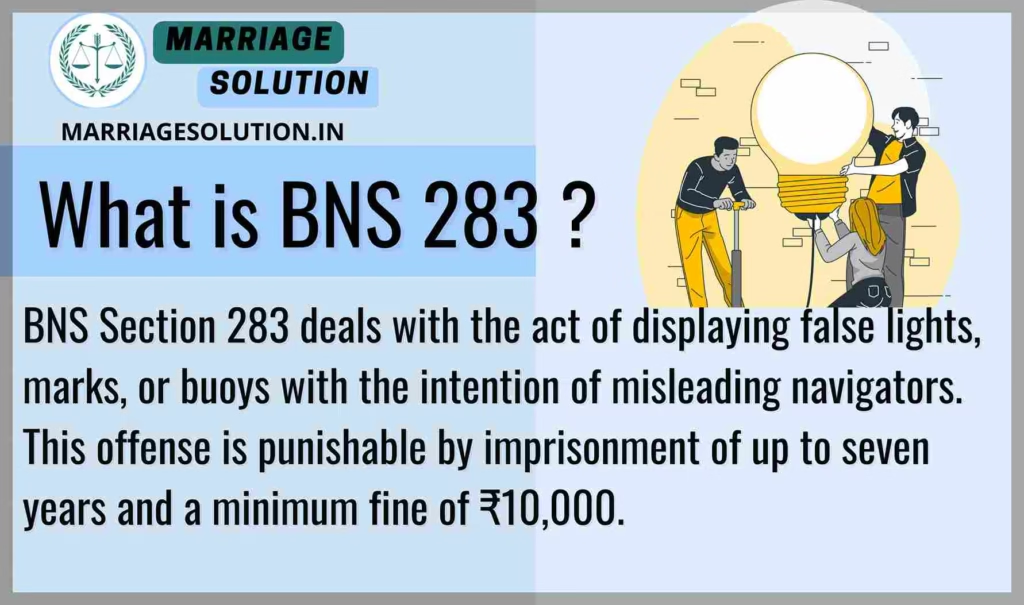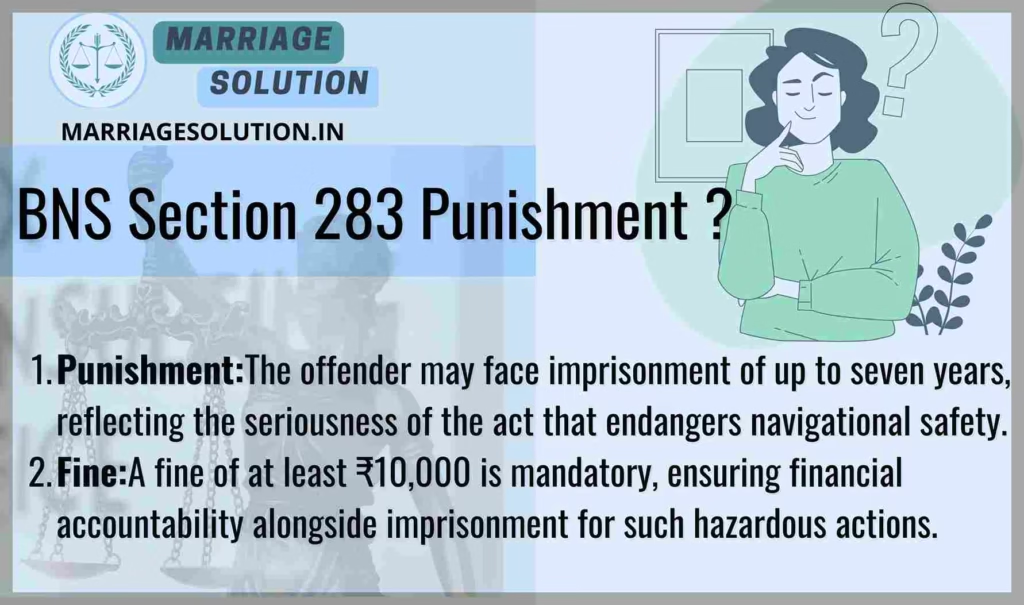Introduction of BNS Section 283
Maritime safety depends heavily on accurate navigation signals like lights, marks, and buoys. Any false or misleading signal can endanger vessels, cause collisions, or even result in shipwrecks. To address this risk, BNS Section 283 penalizes the intentional exhibition of false lights, marks, or buoys designed to mislead navigators. Replacing IPC Section 281, this law provides strict punishments, including imprisonment of up to seven years and a mandatory fine of ₹10,000. It ensures accountability and acts as a deterrent to anyone attempting to disrupt navigation or endanger maritime life.
The Bharatiya Nyaya Sanhita (BNS) Section 283 replaces the old Indian Penal Code (IPC) Section 281.
What is BNS Section 283 ?
BNS Section 283 deals with the act of displaying false lights, marks, or buoys with the intention of misleading navigators. This offense is punishable by imprisonment of up to seven years and a minimum fine of ₹10,000.

BNS 283 in Simple Points
1. Intentional Act of Misleading Navigators
BNS Section 283 targets individuals who intentionally exhibit false lights, marks, or buoys to mislead navigators. Such actions are deliberate, with the offender aware of their potential to cause harm. For example, displaying a fake lighthouse near dangerous rocks can deceive ship captains, leading to accidents or shipwrecks. The law recognizes the grave risks these deceptive practices pose to maritime safety.
2. Serious Penalties Reflecting the Gravity of the Offense
The section prescribes a punishment of up to seven years of imprisonment along with a mandatory fine of ₹10,000. This strict penalty highlights the seriousness of the offense, as it can endanger lives and disrupt maritime activities. The combination of imprisonment and fine ensures that offenders face both punitive and financial consequences for their actions.
3. Impact on Maritime Safety
False signals or marks can create confusion among navigators, especially in crowded shipping routes or during adverse weather conditions. Such acts jeopardize not only the safety of crew and passengers but also the cargo and vessels. By criminalizing these acts, BNS Section 283 safeguards the integrity of maritime navigation and prevents potential disasters.
4. Cognizable and Bailable Nature
The offense is classified as cognizable, allowing law enforcement to take immediate action without prior approval from a magistrate. This ensures swift intervention to mitigate risks posed by such deceptive practices. At the same time, being bailable, the accused has the opportunity to apply for bail, balancing the rights of the accused with the need for public safety.
5. Trial by Magistrate of the First Class
Cases under BNS Section 283 are tried by a Magistrate of the First Class, ensuring a fair and competent judicial process. This classification reflects the offense’s seriousness, entrusting it to experienced judicial officers. The trial aims to ensure justice for victims and act as a deterrent to potential offenders.
Section 283 BNS Overview
BNS Section 283 penalizes anyone who exhibits false navigational signals intending to mislead sailors or navigators. The act endangers human life and property, leading to severe punishment.
10 Key Points of BNS Section 283
1. Intentional Exhibition of False Signals
BNS Section 283 punishes individuals who intentionally display false lights, marks, or buoys. This act is deliberate, with the offender knowing it could mislead navigators. For example, setting up a false lighthouse near rocky shores to deceive ships into a collision.
2. Endangerment of Human Life and Property
Such acts pose significant risks to human life and property. Misleading navigators can result in shipwrecks, grounding, or accidents, endangering lives and causing extensive damages to goods or vessels.
3. Imprisonment for Seven Years
The law provides for imprisonment of up to seven years, showing the gravity of this offense. This penalty reflects the potential consequences of such actions, such as loss of life or significant damage to maritime operations.
4. Mandatory Fine of ₹10,000
A minimum fine of ₹10,000 is imposed on offenders. This ensures that even if imprisonment is not levied, the financial burden acts as a deterrent. Higher fines may be applicable depending on the circumstances of the offense.
5. Cognizable Offense
BNS Section 283 is a cognizable offense, allowing law enforcement authorities to initiate investigations and arrests without prior approval from a magistrate. This ensures quick action to prevent further harm.
6. Bailable Nature
The offense is bailable, meaning the accused can apply for bail after arrest. This ensures the legal rights of the accused while maintaining the seriousness of the trial process.
7. Non-Compoundable Offense
Being non-compoundable, the offense under BNS Section 283 cannot be settled out of court. The case must be prosecuted in a court of law, emphasizing the public interest in addressing maritime safety violations.
8. Trial by Magistrate of the First Class
The case is triable by a Magistrate of the First Class. This ensures a fair and competent judicial process for handling offenses that involve safety and navigation risks.
9. Importance of Maritime Safety
The law prioritizes maritime safety, recognizing the critical nature of navigational aids in avoiding accidents. Misleading navigational signals can cause chaos in busy sea lanes or ports, disrupting trade and endangering lives.
10. Preventive and Deterrent Measure
BNS Section 283 acts as both a preventive and deterrent measure, discouraging individuals from endangering maritime safety through false signals. The strict punishment and mandatory fine emphasize the importance of secure and reliable navigational aids.
Examples of BNS Section 283
Example 1: False Lighthouse Signal
An individual sets up a false lighthouse near a rocky coastline to deliberately mislead incoming ships for personal gain. This act leads a cargo vessel to ground on the rocks, endangering lives and causing economic loss.
Example 2: Buoy Alteration in River
A fisherman relocates a navigation buoy to restrict boat traffic near his fishing spot. This act misguides a passenger ferry, resulting in a collision with another vessel.
BNS 283 Punishment
- Punishment:
The offender may face imprisonment of up to seven years, reflecting the seriousness of the act that endangers navigational safety. - Fine:
A fine of at least ₹10,000 is mandatory, ensuring financial accountability alongside imprisonment for such hazardous actions.

BNS 283 bailable or not ?
BNS Section 283 is bailable, meaning the accused can apply for bail after being arrested. However, the offense remains serious due to its cognizable and non-compoundable nature, making it a significant legal concern.
Comparison Table – BNS 283 vs IPC 281
| Section | What it Means | Punishment / Consequence | Bailable | Cognizable | Trial By |
|---|---|---|---|---|---|
| BNS Section 283 | Deals with the intentional exhibition of false lights, marks, or buoys to mislead navigators or endanger maritime safety. Targets deliberate acts that can cause shipwrecks or navigational hazards. | Imprisonment up to 7 years and a mandatory fine of ₹10,000. Ensures strong deterrence and accountability for maritime deception. | Bailable | Cognizable | Magistrate of the First Class |
| IPC Section 281 (Old) | Covered exhibiting false lights, marks, or buoys with intent to mislead navigators. Aimed at preventing deception at sea but lacked specific fine requirements. | Imprisonment up to 7 years, or fine, or both. No mandatory fine specified, making penalties less stringent. | Bailable | Cognizable | Magistrate of the First Class |
| Key Difference: BNS Section 283 replaces IPC Section 281 by adding a mandatory ₹10,000 fine and clearer wording on intent to mislead navigators. It strengthens maritime safety laws and modernizes enforcement standards. | |||||
BNS Section 283 FAQs
What is the punishment under BNS Section 283?
The punishment includes imprisonment of up to seven years and a mandatory fine of at least ₹10,000.
Is BNS Section 283 bailable?
Yes, the offense is bailable, allowing the accused to seek release while awaiting trial.
Who tries cases under BNS Section 283?
Cases under this section are tried by a Magistrate of the First Class.
What kind of offense is it under BNS 283?
The offense is cognizable, bailable, and non-compoundable.
What actions are prohibited under BNS Section 283?
Exhibiting false lights, marks, or buoys with the intent to mislead navigators is prohibited.
Conclusion
BNS Section 283 plays a crucial role in maintaining maritime safety by criminalizing the exhibition of false navigational signals. With a punishment of up to 7 years of imprisonment and a mandatory fine, it sends a strong deterrent message. By replacing IPC Section 281, this law modernizes the provision and strengthens accountability. It ensures that navigators can trust maritime aids, protecting both lives and property at sea.
Need Legal Support?
If you are dealing with court cases, marriage problems, or any other legal issue, our team at Marriage Solution – Lawyer Help is here for you. Simply fill out our quick online enquiry form, and we’ll connect you with the right legal expert to support your needs.
Finished with BNS 283 ? Continue exploring the next provisions of the Bharatiya Nyaya Sanhita (BNS), 2023. Each section includes explanations, examples, and plain-language breakdowns for easy understanding.
- 284 BNS : Conveying person by water for hire in unsafe or overloaded vessel.
- https://marriagesolution.in/bns_section/284-bns/
- 285 BNS : Danger or obstruction in public way or line of navigation.
- https://marriagesolution.in/bns_section/285-bns/
- 286 BNS : Negligent conduct with respect to poisonous substance.
- https://marriagesolution.in/bns_section/286-bns/
- 287 BNS : Negligent conduct with respect to fire or combustible matter.
- https://marriagesolution.in/bns_section/287-bns/
- 288 BNS : Negligent conduct with respect to explosive substance.
- https://marriagesolution.in/bns_section/288-bns/
Full IPC Section List: https://marriagesolution.in/ipc-section-list
All Indian Law & Blogs: https://marriagesolution.in/indian-law/
Full BNSS Section List: https://marriagesolution.in/bnss_section-list
